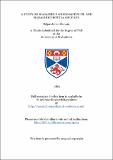Files in this item
A study on Marasmius androsaceus Fr. and Marasmius rotula (scop) Fr
Item metadata
| dc.contributor.advisor | Macdonald, James Alexander | |
| dc.contributor.author | Duncan, Edgar Julian | |
| dc.coverage.spatial | 2 v. | en_US |
| dc.date.accessioned | 2018-06-19T14:43:15Z | |
| dc.date.available | 2018-06-19T14:43:15Z | |
| dc.date.issued | 1963 | |
| dc.identifier.uri | https://hdl.handle.net/10023/14274 | |
| dc.description.abstract | i) Nuclear division in the fungi, particularly in the basidiomycetes, is briefly reviewed, and three questions arising out of this have been posed: (a) How do nuclei divide as seen in live observations? (b) How do nuclei of vegetative hyphae divide as seen from fixed and stained preparations? (c) How closely do meiotic divisions I and II in the basidium resemble meiosis in higher plants? ii) The classification and affinities of Marasmius androsaceus and M. rotula are briefly discussed, and work carried out on the organisms has been described. iii) Live observations using phase contrast microscopy were carried out on the organisms, and the mycelia in culture were described. From live observations it was found that (a) growth takes place at the tip of the hypha, and is uninterrupted during the production of clamp connection on the hypha, (b), there is an apparent correlation between the tip of the hypha and the fore nucleus which is usually approximately 120M from the tip, (c) during nuclear division the central grey body of the nucleus disappears, and the clear area only is seen, which eventually disappears too, (d) the filiform mitochondria change their shape constantly, and form a spherical body behind the septum across the main hypha prior to the fusion of clamp with the main hypha, after which they revert to their filiform shape, and (e) the granules within the cytoplasm give positive reaction to the Nadi reagent and Tetrazolium chloride, suggesting they might be mitochondria. These findings are discussed in the light of findings of other workers on other basidiomycetes. iv). The cytology of the basidia has been studied, using the squash technique after staining with Aceto-orcein or Feulgen and Fast Green. The anatomy of the fructifications is described; the findings were in the main (a) there are two types of elements in the hymenium, which agrees with Kuhner's findings; (b) the cells of the fructification are binuoleate, this condition being maintained by the production of clamps at the time of somatic nuclear division; (c) the chromosomes of the nucleus appear to be arranged linearly on a strand, which divides as a unit (d) the fusion nucleus in the basidium divides meiotically, but the bivalents become joined one to the other during diakinensis, and afterwards behave as a unit; (e) division II of meiosis resembles the division in the ultimate clamp; (f) some or all of the nuclei resulting from the meiotic division may undergo an additional 'mitotic' division giving rise to from 4 to 8 nuclei within the basidium which may lead to amphithallism; (g) the species are both tetrapolar. These findings are discussed and compared with findings of other authors in other basidiomycetes, and an explanation of the 'two metaphase chromosomes' which has puzzled many workers, is offered. (V) The division of the nuclei in the vegetative hyphae is studied from fixed and stained preparations, using Feulgen and Fast Green. The division is found to be the same as that of the nuclei in the 'ultimate clamp' and the division II of meiosis: this, in brief, is: - 1) The beaded double strand of four chromosomes (doubled during replication) splits, and the nucleolus disappears. 2) The sister strands open apart from each other, remaining joined at one or both ends. 3) The ring so formed expands and undergoes a twist into a figure of eight. 4) The loops of the figure bend over on each other to form a double ring of beaded chromatin. 5) A break appears in the rings and the arras open out linearly. 6) Anaphase separation takes place, during which bridges of chromatin are seen. 7) At telophase four chromosomes are seen which form a circle before the nucleus is reorganised. A case for the justification of calling the division a mitotic division though different from classical mitosis is presented. | en_US |
| dc.language.iso | en | en_US |
| dc.publisher | University of St Andrews | |
| dc.subject.lcc | QK629.M2D8 | en |
| dc.subject.lcsh | Marasmius | en |
| dc.title | A study on Marasmius androsaceus Fr. and Marasmius rotula (scop) Fr | en_US |
| dc.type | Thesis | en_US |
| dc.contributor.sponsor | University of the West Indies. Sir James Irvine Memorial Scholarship | en_US |
| dc.type.qualificationlevel | Doctoral | en_US |
| dc.type.qualificationname | PhD Doctor of Philosophy | en_US |
| dc.publisher.institution | The University of St Andrews | en_US |
This item appears in the following Collection(s)
Items in the St Andrews Research Repository are protected by copyright, with all rights reserved, unless otherwise indicated.

